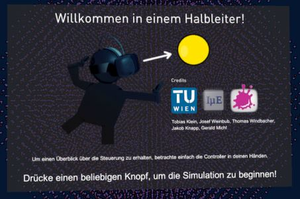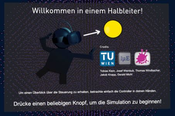Information
- Publication Type: Bachelor Thesis
- Workgroup(s)/Project(s):
- Date: September 2017
- Date (Start): February 2017
- Date (End): 23. September 2017
- Matrikelnummer: 1327386
- First Supervisor: Tobias Klein
Abstract
Due to Virtual Reality’s recent rise in popularity, other application areas apart from the entertainment sector have shown interest to use VR applications for their purposes. In this thesis, a VR simulation, which enables the user to maneuver an electron through a virtual semiconductor’s crystalline atomic structure, is devised on behalf of the Institute of Microelectronics at the TU Wien. The application is based upon the cellVIEW framework, which was developed using the Unity game engine to visualize large sets of biomolecular data in real time. At first, background regarding the topic at hand is provided by defining what VR is, how it is achieved and how it has evolved from Charles Wheatstone’s stereoscope to the HTC Vive VR system. Building upon that knowledge, the reader is introduced to the main problems that research in the field of Virtual Reality is currently facing, especially considering the avoidance of VR sickness. For the development of the simulation devised in the course of this thesis, two main obstacles had to be overcome: moving the user through the virtual world without causing discomfort and handling collisions between the electron and the thousands of atoms in the crystal structure without losing performance. To address the first issue, related work is reviewed and drawn inspiration from. To avoid “vection”, movement in our simulation is limited to the forward direction and external forces are applied to a sphere representing the electron instead of influencing the user himself. To keep the frame-rate high despite the potentially large number of atoms in the virtual scene, a space-partitioning octree data-structure has been implemented.Additional Files and Images
Weblinks
No further information available.BibTeX
@bachelorsthesis{Knapp_2017_CVR,
title = "Explorable Semiconductors: Interacting with Crystal
Structures in Virtual Reality",
author = "Jakob Knapp",
year = "2017",
abstract = "Due to Virtual Reality’s recent rise in popularity, other
application areas apart from the entertainment sector have
shown interest to use VR applications for their purposes. In
this thesis, a VR simulation, which enables the user to
maneuver an electron through a virtual semiconductor’s
crystalline atomic structure, is devised on behalf of the
Institute of Microelectronics at the TU Wien. The
application is based upon the cellVIEW framework, which was
developed using the Unity game engine to visualize large
sets of biomolecular data in real time. At first, background
regarding the topic at hand is provided by defining what VR
is, how it is achieved and how it has evolved from Charles
Wheatstone’s stereoscope to the HTC Vive VR system.
Building upon that knowledge, the reader is introduced to
the main problems that research in the field of Virtual
Reality is currently facing, especially considering the
avoidance of VR sickness. For the development of the
simulation devised in the course of this thesis, two main
obstacles had to be overcome: moving the user through the
virtual world without causing discomfort and handling
collisions between the electron and the thousands of atoms
in the crystal structure without losing performance. To
address the first issue, related work is reviewed and drawn
inspiration from. To avoid “vection”, movement in our
simulation is limited to the forward direction and external
forces are applied to a sphere representing the electron
instead of influencing the user himself. To keep the
frame-rate high despite the potentially large number of
atoms in the virtual scene, a space-partitioning octree
data-structure has been implemented. ",
month = sep,
address = "Favoritenstrasse 9-11/E193-02, A-1040 Vienna, Austria",
school = "Institute of Computer Graphics and Algorithms, Vienna
University of Technology ",
URL = "https://www.cg.tuwien.ac.at/research/publications/2017/Knapp_2017_CVR/",
}

 Bachelor Thesis
Bachelor Thesis image
image
